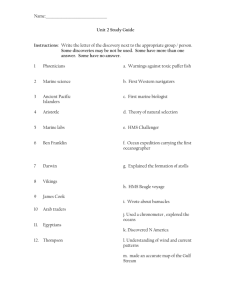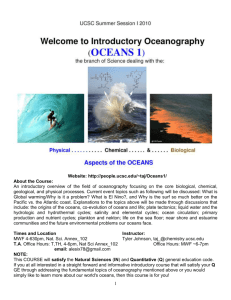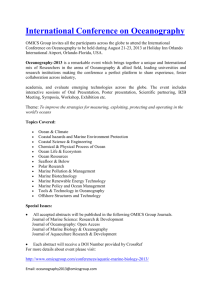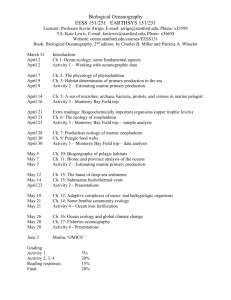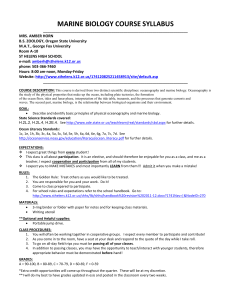Sound in the Sea
advertisement
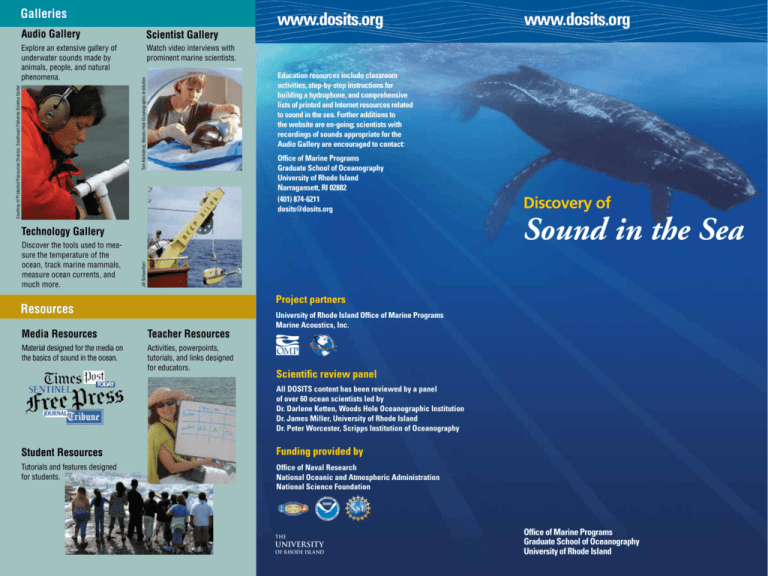
Galleries Scientist Gallery Explore an extensive gallery of underwater sounds made by animals, people, and natural phenomena. Watch video interviews with prominent marine scientists. www.dosits.org Office of Marine Programs Graduate School of Oceanography University of Rhode Island Narragansett, RI 02882 (401) 874-6211 dosits@dosits.org Discovery of Sound in the Sea Jill Schoenherr Technology Gallery Discover the tools used to mea­ sure the temperature of the ocean, track marine mammals, measure ocean currents, and much more. www.dosits.org Education resources include classroom activities, step-by-step instructions for building a hydrophone, and comprehensive lists of printed and Internet resources related to sound in the sea. Further additions to the website are on-going; scientists with recordings of sounds appropriate for the Audio Gallery are encouraged to contact: Tom Kleindinst, Woods Hole Oceanographic Institution Courtesy of Protected Resources Division, Southwest Fisheries Science Center Audio Gallery Project partners Resources Media Resources Teacher Resources Material designed for the media on the basics of sound in the ocean. Activities, powerpoints, tutorials, and links designed for educators. University of Rhode Island Office of Marine Programs Marine Acoustics, Inc. Scientific review panel All DOSITS content has been reviewed by a panel of over 60 ocean scientists led by Dr. Darlene Ketten, Woods Hole Oceanographic Institution Dr. James Miller, University of Rhode Island Dr. Peter Worcester, Scripps Institution of Oceanography Funding provided by Tutorials and features designed for students. Office of Naval Research National Oceanic and Atmospheric Administration National Science Foundation C NI D ATMOSPHER AN IC TRATION NIS MI AD NATIONAL OC EA Student Resources D ER S. CE U. EP AR TME THE UNIVERSITY OF RHODE ISLAND O NT OF C MM Office of Marine Programs Graduate School of Oceanography University of Rhode Island Science of Sound in the Sea People and Sound in the Sea Sound provides a three-dimensional view of the underwater environment that is not limited by light levels. The Discovery of Sound in the Sea website (www.dosits.org) describes how ma­ rine animals and people use sound to sense their surroundings, to communicate, and to navigate. This Internet resource provides scientific information for the general public and K–16 educators and students. It also includes advanced level content appropriate for high school physics or undergraduate classes. The website provides an introduction to underwater acoustics and explains how people and animals use sound to accomplish everyday tasks. There is also an indepth discussion on the effects of underwater sound on marine mammals and fishes. This interactive website has three galleries highlighting sounds in the sea (Audio Gallery), current scientific investigations (Scientist Gallery), and scientific equipment (Tech­ nology Gallery). How fast does sound travel under water? How is sound used to identify fish? Animals and Sound in the Sea How do animals communicate under water? Marine animals produce a variety of underwater vocalizations that can be used to communicate over short or long distances. For example, humpback whales produce a series of vocalizations that collectively form a song that can be heard miles away. 125 250 Time (µs) 375 500 Courtesy of Kelly Benoit-Bird, Oregon State University J.-D. Colladon, Souvenirs et Memoires, Albert-Schuchardt, Geneva, 1893. How does sound travel through the ocean? How do explorers find sunken ships? A sound channel in the ocean allows low-frequency sound to travel great distances. This channel is called the SOund Fixing And Ranging, or SOFAR, channel. Side scan sonar is often used to find objects, like shipwrecks, on the sea­floor. This so­ nar image is of the British freighter Empire Knight that sank in 1944 off the Maine coast. What are common underwater sounds? How is sound used to measure ocean temperature? Ocean temperatures can be calculated by measuring the amount of time it takes for sound to travel a known distance under water. Hydrophone ar­ rays (white dots) have been used to measure the temperature in the North Pacific. 20 16 14 12 10 8 6 4 2 kHz Time (sec) S 0.2 0.4 0.6 0.8 Time (sec) 1 1.2 1.4 The ocean is filled with a variety of sounds. Spectrograms are used to display common under­ water sounds, such as these dolphin signature whistles. Time (sec) Courtesy of Peter Worcester, Scripps Institution of Oceanography Frequency (kHz) Frequency (kHz) 18 Tom Kieckhefer Fish finders use reflected sound to locate fish. Scientists hope to use the unique sonar echoes from different species of fishes in Hawaiian waters to determine population size. Pink snapper, Opakapaka 0 Frequency (kHz) Specific sounds and increased background noise can impact marine animals. The effects vary depending upon the sounds an animal can hear, the intensity and frequency of the sound, and other variables. Long-tailed red snapper, Onaga Paul E. Nachtigall, Hawaii Institute of Marine Biology How are animals affected by underwater sound? In 1826, Daniel Colladon and Charles Sturm measured the speed of sound in water to be five times faster than the speed of sound in air. Courtesy of Klein Associates, Inc. Discovery of Sound in the Sea

